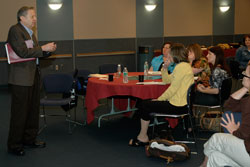- About Ramapo
- Academics
- Admissions & Aid
- Student Life
- Athletics
- Alumni
- Arts & Community
- Quick Links
- Apply
- Visit
- Give
Gumpert Workshop: Rescue and Resistance in Genocide
(PDF) (DOC) (JPG)May 17, 2010
 (MAHWAH, NJ) – “Rescue and Resistance in Genocide”was the title of a Gumpert Teachers’ Workshop held at Ramapo College on May 17, 2010 and sponsored by the Center for Holocaust and Genocide Studies in cooperation with the New Jersey State Commission on Holocaust Education. As with all our workshops, support was also received from the Gumpert Foundation.
(MAHWAH, NJ) – “Rescue and Resistance in Genocide”was the title of a Gumpert Teachers’ Workshop held at Ramapo College on May 17, 2010 and sponsored by the Center for Holocaust and Genocide Studies in cooperation with the New Jersey State Commission on Holocaust Education. As with all our workshops, support was also received from the Gumpert Foundation.
Dr. Mordecai Paldiel, the former Director of the Righteous Among the Nations program at Yad Vashem, Israel was the keynote speaker. Now living in Fort Lee, New Jersey, Dr. Paldiel in his talk, “Rescue and Resistance in the Holocaust: What Lessons Can Be Learned,” focused on what he and colleagues at Yad Vashem, Israel’s Holocaust remembrance authority, learned about nature and motivation of Holocaust rescuers. Given that especially in Poland the Nazi authorities immediately executed anybody hiding or abetting Jews, persons who did so were extraordinary individuals. As Paldiel explained, they were even sometimes even people like Zofia Kossak-Szczucka, one of the founders of the Polish resistance group Zegota established to save Jews, who described herself as a nationalist and an anti-Semite. In her mind, Paldiel made clear, there was no inconsistency in her behavior, since as a Christian she believed every human being has the right to live and “?¦be loved by his fellow men.” Kossak-Szczucka, according to Paldiel, like so many other rescuers in a sense “stepped out.” She had had enough and became a new person.
Next on the agenda was Frances Flannery who offered workshop participants strategies and tips from her many years of experience teaching about rescue and resistance in her Social Studies classes at South Plainfield High School. Familiarity with student thinking, she told participants, has led her to believe that a discussion of bystander behavior can be a very effective entry point for a discussion of rescue in genocide. It gets students reflecting very quickly on what motivates an individual, despite the risks, to come to the aid of a fellow human being. In similar fashion to Paldiel, she pointed out that it is crucial for students to understand that people can go against type and do the right thing. It can trigger students, she emphasized, to modify their behavior even on a daily basis.
An expert on Holocaust and genocide studies, Fran Flannery attended the Belfer Conference at the United States Holocaust Memorial Museum and completed the Master Teacher Institute for Holocaust Educators at Rutgers University. She also participated in the 2006 New Jersey Holocaust Commission study tour to Holocaust sites in Europe.
Concluding the workshop was Charles Roman of Teaneck, New Jersey who as a teenager fled with his mother fled to France in 1939. You could have heard a pin drop as Mr. Roman told of his odyssey through France and Italy until he and his mother were able to make their way to Rome on June 4, 1944, when it was liberated by American troops. Namely, as Mr. Roman recounted, in those five years he was cared for by nuns in a hospital, for two years placed in a Jewish-run children’s home in mother were instructed to return to Austria, but they ignored the authorities and made their way to Paris, whereupon Mr. Romans’s mother then placed him in the care of the OSE. From November 1939 through May 1941, as Mr. Roman explained, he lived at the Chabannes children’s home in the Departement Creuse, hid under an assumed identity in a fascist work camp until he was about to be unmasked, when he fled to join his mother in the Italian-occupied mountain village of St Martin Vesubie in Alpes-Maritime. It was from there that Mr. Roman and his mother began their trek across the mountains into Italy, where they found refuge in Valle Stura, where local villagers lent considerable assistance to the 40-50 Jewish refugees who were hiding in the area.
Mr. Roman illustrated his story with photographs that he and his mother took to document their flight. Also shown was a preliminary copy of A Pause in the Holocaust, a film by Andre Waksman, that tells the tale of how St Martin Vesubie became a refuge for assorted group of 2,500 Jews from Nice, and how they were forced to flee in when the Nazis occupied the area following the surrender of the Italians in June 1943.
E-News Archives
| 2023 | 2022 | 2021 | 2019 | 2018 | 2017 | 2016 | 2015 | 2014 | 2013 | 2012 | 2011 | 2010 | 2009 | 2008 | 2007 |Copyright ©2025 Ramapo College Of New Jersey. Statements And Policies. Contact Webmaster.

Follow Us!